Abstract
Background:
In Togo, a little is known about latex plants of the flora used for medicinal purposes.
Objective:
The aim of this study was to identify the latex plant species and their medicinal uses in the Maritime Region of Togo.
Materials and Methods:
The methodology was based on ethnobotanical semi-structural individual interviews of 220 informants. Quantitative ethnobotanical index was used to analyze the data.
Results:
A total of 33 latex plants species were recorded, from 12 botanical families and 24 genera. The most represented families were Euphorbiaceae and Moraceae with eight species each. The relative importance (RI) value of each species and the informant consensus factor (ICF) of the ailments categories showed that Pergularia daemia (Forssk.) Chiov. (RI = 2.00) and Euphorbia hirta L. (RI = 1.91) were the most versatile in relation to their uses, and infectious diseases (ICF = 0.922) were the category with the greatest consensus among 17 categories.
Conclusion:
These latex plants of Togolese flora are variously used in traditional medicine and it would be important to undertake further investigations in phytochemistry, pharmacology, and toxicology to validate their uses.
Abbreviations Used: UV: use value ICF: informant consensus factor RI: relative importance PP: pharmacological properties attributed to a species for a specific ailments AC: ailment categories treated by a given species
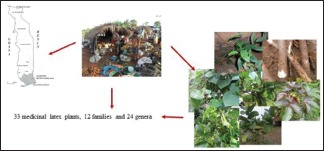
Keywords: Ethnobotany, folk medicine, latex plants, survey, togo
INTRODUCTION
In developing countries, up to 80% of the population still relies on the traditional medicine for their primarily health care.[1] Medicinal plants constitute the basis of health care systems in many societies. The recovery of the knowledge and the practices associated with these plant resources are a part of an important strategy linked to the conservation of the biodiversity, discovery of new medicines, and bettering the quality of life of poor rural communities. Ethnobotanical studies of medicinal plants have taken many paths, sometimes testing hypotheses of the use and the knowledge,[2] or sometimes describing the use of plants in given cultural contexts.[3] However, indigenous knowledge of using medicinal plants for healing human ailments is, in danger of gradually becoming extinct, because this knowledge is passed on orally from generation to generation without the aid of a writing system and many traditional healers do not keep written records.[4] Consequently, little is known about the medicinal practices of the indigenous people.
In Togo, a country located in Western Africa with a border on the Atlantic Ocean in the South, in recent years, the plants used traditionally for therapeutic purposes have attracted the attention of researchers.[5,6,7,8,9,10] In spite of these studies, little is known about latex plants of Togolese flora used for medicinal purposes.
Plant latex is a good source of various secondary metabolites, which shows growth inhibitory effects in bacteria, fungi, viruses, tumors, and cancer cell lines. It shows toxicity to insects, act as growth and reproductive cycle inhibitor. It also shows cytotoxic and anticancer activity and is widely used as laxative, anti-arthritic and as conditioning agents for cosmetic purposes.[11]
This paper seeks to contribute to the knowledge of the latex plants used medicinally by the inhabitants of the Maritime Region of Togo, by presenting the results of a descriptive study of the medicinal latex plants, in order to identify the latex plants species used therapeutically and provide baseline information for future pharmacological, phytochemical, and toxicological studies.
MATERIALS AND METHODS
Study area
Togo is a Western African country lying between Burkina Faso in the North, Benin in the East, and Ghana in the West. Togo's coastline in the South stretches for a distance of 54 km. The country is divided into five economic regions from the North to the South: The Savannah Region, Kara Region, Central Region, Plateaux Region, and Maritime Region. The Maritime Region, the study area extends between 1°20’ and 1°50’ East and 6°10’ and 6°60’ North of the equator. It is constituted of seven prefectures: Ave, Bas-Mono, Golfe, Lacs, Vo, Yoto, and Zio. It borders the Plateaux Region, the Republic of Ghana, the Republic of Benin, and the Atlantic Ocean [Figure 1]. The region covers an area of 6100 km2 which is approximately 10.78% of the total of 56,600 km2 land area of Togo mainland. The climate is sub-equatorial with a long rainy season from March to July (maximum in June: 1200 mm), and short rainy season from September to November (maximum in October: 1000 mm). The minimal precipitations for these two seasons are 184.4 mm and 6.9 mm, respectively. The average annual temperature is around 27.5°C with a maximum around 35.1°C in warm season.[6] The region contains disparate forests, relics of gallery forests, savannahs, coastal thickets, meadows, or halophilic marshy.[12] The soil begins after the Atlantic Ocean by series of detrital posteocene age. After this, there are a valley and the flood plains of rivers Haho, Mono, and Zio.[12] The region is inhabited by 2,599,955 people, the main ethnic groups being Ewe, Ouatchi, Mina, Fon, and Adja.[13] Globally, the region benefits from an excellent biodiversity of medicinal plants.[14]
Figure 1.
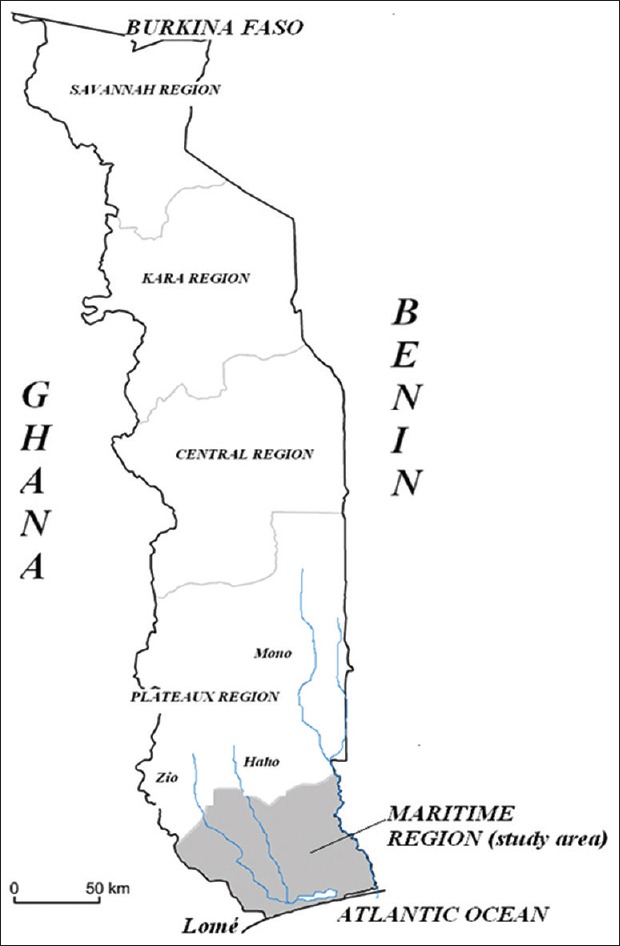
Map of Togo showing the Maritime Region
Data collection
Information was obtained from the traditional healers using a semi-structured questionnaire.[15] The survey was realized from June to December 2013, after their informed consent. Questions asked were about (i) the traditional healer or herbalist identity (name and surname, sex, age, and level of education), (ii) the origin of their knowledge, (iii) the uses of latex plants, and (iv) the professional experience. Information was also gathered on access to the plants and restrictions on their use. Every informant was asked to sign a consent form certifying his agreement with the form which was edited to explain the importance of the information they would provide.
Plant identification
After interviews, preliminary identification of the plants was done in the field by a botanist. Afterward, herbarium specimens were prepared, and photographs were taken to aid in the confirmation of the identity of the plants. Plant identities were confirmed by giving a voucher specimens number at the Herbarium of the Botany Department, University of Lomé.
Data analysis
Initially, the information about the uses of the species collected, along with botanical information, was compiled into a database. The species were listed in alphabetical order by family, local name in the region, medicinal uses, used parts, and herbarium number. Ethnobotanical data were analyzed and summarized by using Microsoft excel. Excel spreadsheet was used to make simple calculations and determine the quantitative ethnobotanical index.
Use value
The use value (UV), a quantitative method that demonstrates the relative importance (RI) of species known locally, was calculated according to the following formula:[16]

Where: “UV” is the UV of species, “U” is the total number of use reports per species and “n” represents the total number of informants interviewed for a given plant. Values will be high (near 1) if there are many use reports for a plant, implying that the plant is important, and near 0 if there are few reports related to its use.
Relative importance
The RI value was calculated according to the following formula:[15,17]
RI = PP + AC
Where: “PP” is obtained by dividing the number of pharmacological properties attributed to a species for a specific ailments divided by the maximum number of properties attributed to the most resourceful species, species with the highest number of properties; “AC” is the number of ailment categories treated by a given species divided by the maximum number of ailment categories treated by the most resourceful species. The highest possible value of RI is 2.0, which indicates the highest diversity of medicinal uses of a plant.
Informants consensus factor
Different specific uses were reported by the informants for the latex plants and that were broken down into a certain number of use categories according to previous studies.[15,17,18] The specific use category, concerns various diseases. The informant consensus factor (ICF) was calculated according to Heinrich et al.[19] as following:

Where “Nar” is the sum of the uses registered by each informant in a given category, Na is the number of species indicated in that category. The ICF was used to identify which category was most important in the interviews. The maximum ICF value possible is 1, when there is a total consensus among the informants about the medicinal plants for a given category.
RESULTS
Informants’ profile
A total of 220 informants (120 men and 100 women) were interviewed. They aged from 25 to 87 years, and the average age is 51.6 ± 11.1 years. The informants in the range of 46–60 years were in the majority and accounted for 53.6%. According to the results, 34.1% were illiterates, 30.0% attended primary school, 30.9% the secondary school, and only 5.0% of the informants attended the university. The ethnic groups of the informants were Ewe (39.5%), Ouatchi (33.6%), Mina (17.3%), and others such as Adja (4.5%), Kotokoli (2.3%), Kabyè (0.9%), Pédah (0.9%), and Akposso (0.5%). For the origin of their knowledge, the majority of the traditional healers (84.5%) inherited the knowledge from their families, while 0.9% received their knowledge through divine revelation. The traditional healers who inherited both from their families and from training represented 7.7% and 6.4% only from training. The traditional healers were experienced from 1 to 60 years but the majority (85.9%) was experienced from 1 to 30 years [Table 1].
Table 1.
Profile of the traditional healers interviewed
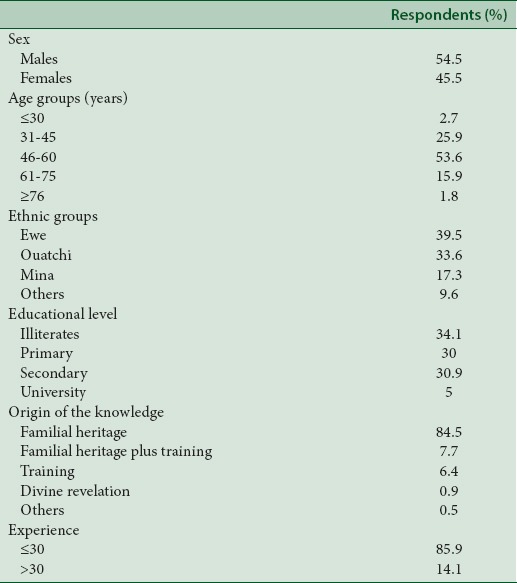
Taxonomic diversity and use values
In this study, 33 medicinal latex plant species belonging to 24 genera and 12 families were recorded. The most represented families were Euphorbiaceae and Moraceae with eight species each, followed by Asclepiadaceae with five species and Apocynaceae with four species. The others families were represented by one species each [Table 2]. The life forms indicated that 43% of the reported species were shrub following by tree and liana (21% each), and herb (15%).
Table 2.
List of medicinal latex plants investigated with their related information
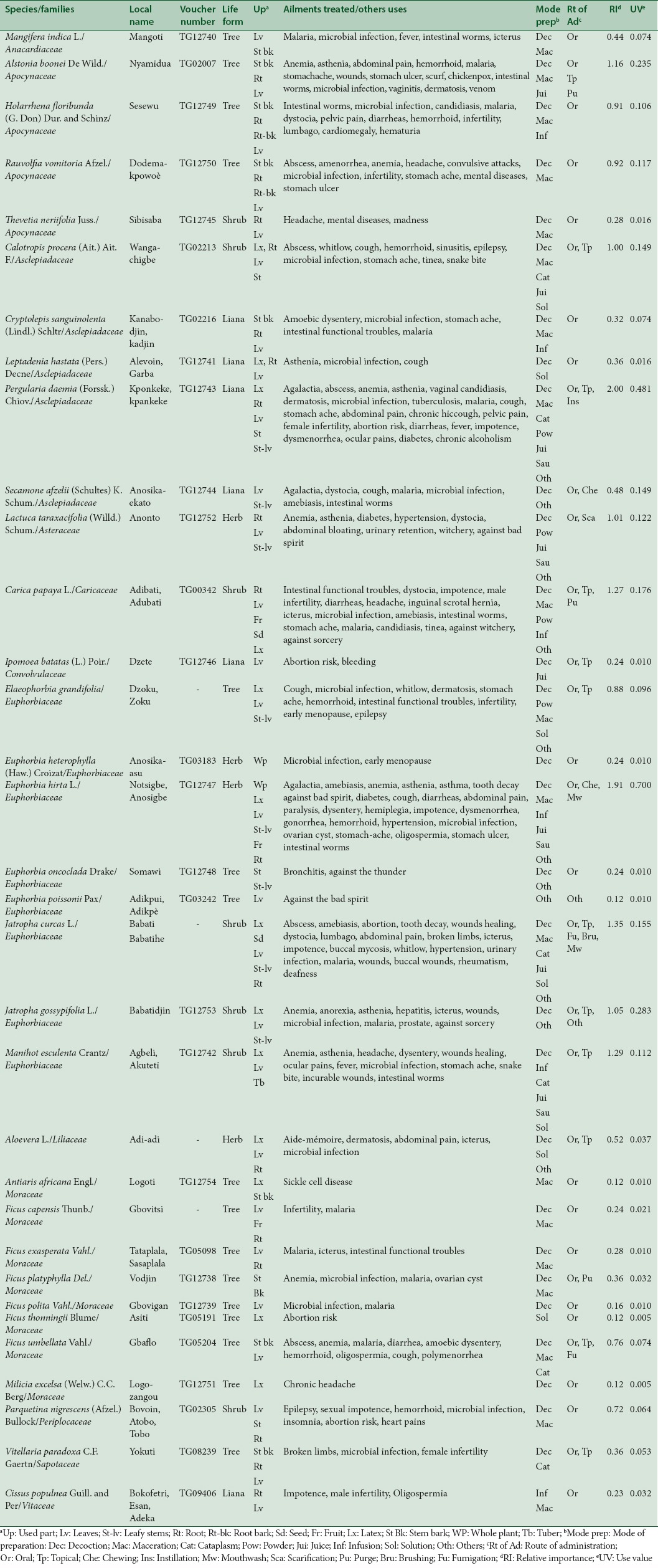
The latex plants most used by the traditional healers of the Maritime Region of Togo were Euphorbia hirta L. (UV = 0.700), Pergularia daemia (Forssk.) Chiov. (UV = 0.481), Jatropha gossypifolia L. (UV = 0.283), and Alstonia boonei De Wild. (UV = 0.235), followed by Carica papaya L. (UV = 0.176), Jatropha curcas L. (UV = 0.155), Calotropis procera (Ait.) Ait. F. (UV = 0.149), and Secamone afzelii (Schultes) K. Schum. (UV = 0.149). The lowest UV calculated was 0.005 for Ficus thonningii Blume, and Milicia excelsa (Welw.) C.C. indicating that these plants were rarely used by the informants [Table 2].
Relative importance
This study showed that the highest diversity use species were P. daemia (Forssk.) Chiov. (RI = 2.00), and E. hirta L. (RI = 1.91). P. daemia (Forssk.) Chiov was used for 26 pharmacological properties in 12 ailments categories and E. hirta, 26 pharmacological properties in 11 ailments categories. These two species were followed by J. curcas L. (RI = 1.35), Manihot esculenta Crantz (RI = 1.29), C. papaya L. (RI = 1.27), A. boonei De Wild. (RI = 1.16), J. gossypifolia L. (RI =1.05), Lactuca taraxacifolia (Willd.) Schum. (RI = 1.05), and C. procera (Ait.) Ait. F. (RI = 1.00). The RI values of the others species were <1.00 (RI <1.00) and three species were mentioned for only one specific use [Table 2].
Informants consensus factor
Traditional healers use 33 medicinal latex plants for 82 diseases or specific uses in Maritime Region of Togo. These diseases were grouped into 17 use categories: Infectious diseases, gastrointestinal diseases, problems of the nervous system, gynecological problems, problems of the respiratory system, dermatological problems, diseases of the endocrine glands, diseases of the blood and hematopoietic organs, problems of the visual system, cardiovascular diseases, problems of the otorhinolaryngology and stomatology system, pediatrics, urologic problems, rheumatology-orthopedics, psychiatric diseases, magico-spiritual problems, and poisoning problems. The informants agree in the treatment of all the ailments categories except urologic problems [Table 3]. The categories with the greatest consensus among the informants were: Infectious diseases (ICF = 0.922), followed by problems of the respiratory system (ICF = 0.844), gynecological problems (ICF = 0.793), and gastrointestinal diseases (ICF = 0.735) meaningful that the traditional healers surveyed agree more in the treatment of these diseases. The informants use 24 latex plants species for infectious diseases, followed by 20 for gynecological problems and 19 for gastrointestinal diseases.
Table 3.
Informant consensus for diseases treated with medicinal latex plants used by the inhabitants in Maritime Region of Togo
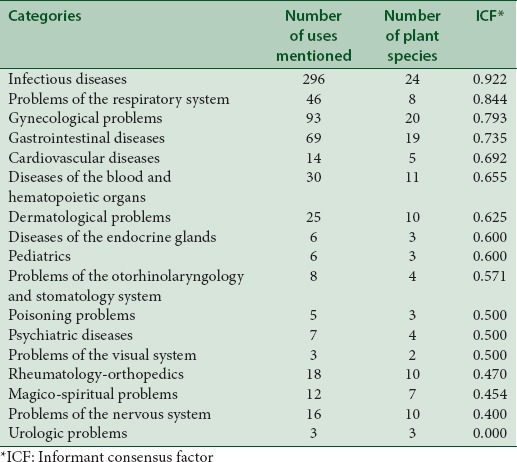
Plant parts used, preparation methods, and route of administration
The latex plant parts used in the study area were: Leaves, stem, stem bark, leafy stems, roots, root bark, seeds, fruits, latex, tuber, and whole plant [Figure 2]. The most frequently used part is the leaves (35.07%), followed by leafy stems (20.35%), stem bark (15.68%), roots (14.03%), latex (6.18%), whole plant (5.38%), and others (3.33%) including root bark, seeds, fruits, stem, and tuber. Latex plants are prepared and administrated in different ways. The decoction (67.9%) is the main form of preparation [Figure 3]. Others forms of preparations are maceration (10.4%), crude latex (5.8%), sauce (4.7%), juice (4.0%), poultice (2.8%), and infusion and powder (1.5% each). The concoctions are mainly administered by oral route (90.7%) linked to the form of preparation.
Figure 2.
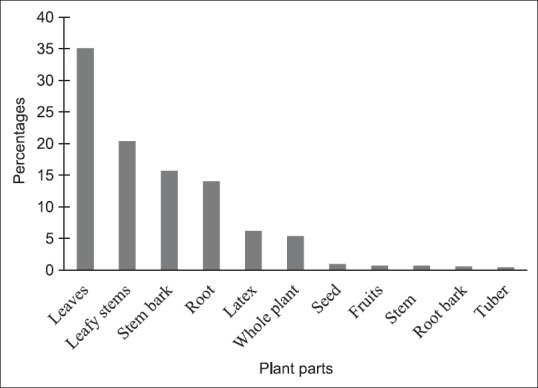
Frequency of latex plant used parts by the traditional healers of the study area
Figure 3.
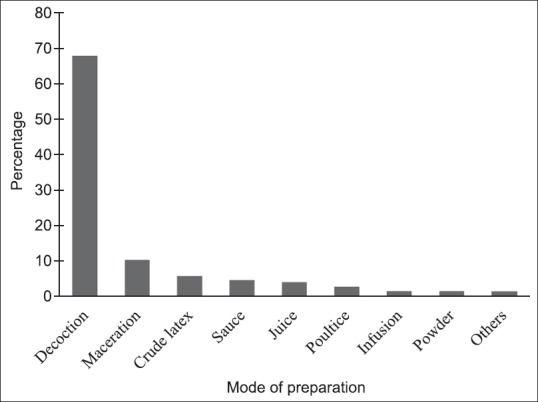
Mode of preparation of phytomedicine
DISCUSSION
This study aimed to identify the latex plants and their medicinal uses. The species recorded are mostly belonging to Euphorbiaceae, Moraceae, Asclepiadaceae, and Apocynaceae families. According to literature, these families recorded the greatest number of latex plants.[14] The main life form of the reported species was a shrub. This is in contradiction with others studies in the same area and elsewhere, where herbaceous plants are the most reported species.[6,17] This may be due to the fact that this study is focused in the “group of plants” which has commonly a latex, and not in disease or medicinal plants in general.
The RI of the species showed two species: P. daemia (Forssk.) Chiov, and E. hirta L. with the highest diversity of uses. The high versatility of medicinal plants could indicate the higher diversity of active compounds contained by the species but there are few ethnobotanical and pharmacological studies in our study area to prove it.[6,8,20,21] Eight species of Togolese flora cited in this study were reported by Koudouvo et al.,[6] in an ethnobotanical study of antimalarial plants in the same area. Likewise, 9–13 species reported in this study were also documented by several authors in different countries.[22,23] The species demonstrating the highest RI values in this study had scientifically proven for some pharmacological properties. Thus, P. daemia (Forssk.) Chiov., E. hirta L., J. curcas L., J. gossypifolia L., A. boonei De Wild., Rauwolfia vomitoria Afzel., C. papaya L., C. procera (Ait.) Ait. F., Cryptolepis sanguinolenta (Lindl) Schltr had been shown to possess activities against microbes, parasites, or to possess anti-inflammatory, antioxidant, and anticancer activities.[24,25,26] Some of the species cited in our survey had not yet been studied for their pharmacological activities, indicating the need of more studies.
According to the ICF, the informants agree more in the treatment of all the ailments categories except urologic problems category, and the infectious diseases category had the greatest consensus among the informants. These results are in accordance with those previous studies in which these use categories were found among those with the greatest consensus.[15,27] The use of a large number of medicinal latex plants for the treatment of infectious diseases in the region could be due to the high occurrence of these problems in the study area, due to poor hygiene, and other factors like water and air pollution.
Concerning the plant parts used, preparation methods, and route of administration, many ethnobotanical surveys had shown that the leaves are most frequently used as decoction and administrated orally.[6,28,29] The leaves and leafy stems are predominantly used because they are collected very easily than underground parts, fruits, and others,[30] and in scientific point of view leaves are active in photosynthesis and production of metabolites.[31] Beside this, another important reason of using leaves could be concerning conservation of the plants as digging out roots might be the cause of death of the plant and putting the species in a vulnerable condition.[28]
CONCLUSION
This study revealed that the latex plants are variously used in the Maritime Region of Togo by the traditional healers to treat many ailments but there is a little scientific information available concerning many of them. Thus, the results of this survey represent a baseline for selection of species for further phytochemical, pharmacological, and toxicological investigations. Additional studies are also necessary to identify possible difference uses between ethnic groups of the studied area in order to know how the traditional healers select these plants.
Financial support and sponsorship
Nil.
Conflicts of interest
There are no conflicts of interest.
ABOUT AUTHOR
Prof. Simplice Damintoti Karou, PhD Biochemistry/Microbiology Ecole supérieure des Techniques Biologiques et Alimentaires (ESTBA-UL), Université de Lomé. E-mail: simplicekarou@hotmail.com
REFERENCES
- 1.WHO. Regional Office for Africa. The African Regional Health Report. 2014. [Last cited on 2015 Jan 20]. Available from: http://www.afro.who.int/en/publications.html .
- 2.Reyes-Garcia V, Vadez V, Huanca T, Leonard W, Wilkie D. Knowledge and consumption of wild plants: A comparative study in two Tsimane’ villages in the Bolivian Amazon. Ethnobotany Res Appl. 2005;3:201–7. [Google Scholar]
- 3.Gazzaneo LR, de Lucena RF, de Albuquerque UP. Knowledge and use of medicinal plants by local specialists in a region of Atlantic Forest in the state of Pernambuco (Northeastern Brazil) J Ethnobiol Ethnomed. 2005;1:9. doi: 10.1186/1746-4269-1-9. [DOI] [PMC free article] [PubMed] [Google Scholar]
- 4.Kaido TL, Veale DJ, Havlik I, Rama DB. Preliminary screening of plants used in South Africa as traditional herbal remedies during pregnancy and labour. J Ethnopharmacol. 1997;55:185–91. doi: 10.1016/s0378-8741(96)01499-7. [DOI] [PubMed] [Google Scholar]
- 5.Tchacondo T, Karou SD, Batawila K, Agban A, Ouro-Bang’na K, Anani KT, et al. Herbal remedies and their adverse effects in Tem tribe traditional medicine in Togo. Afr J Tradit Complement Altern Med. 2011;8:45–60. doi: 10.4314/ajtcam.v8i1.60522. [DOI] [PMC free article] [PubMed] [Google Scholar]
- 6.Koudouvo K, Karou DS, Kokou K, Essien K, Aklikokou K, Glitho IA, et al. An ethnobotanical study of antimalarial plants in Togo Maritime Region. J Ethnopharmacol. 2011;134:183–90. doi: 10.1016/j.jep.2010.12.011. [DOI] [PubMed] [Google Scholar]
- 7.Koudouvo K, Karou SD, Ilboudo DP, Kokou K, Essien K, Aklikokou K, et al. In vitro antiplasmodial activity of crude extracts from Togolese medicinal plants. Asian Pac J Trop Med. 2011;4:129–32. doi: 10.1016/S1995-7645(11)60052-7. [DOI] [PubMed] [Google Scholar]
- 8.Hoekou YP, Batawila K, Gbogbo KA, Karou DS, Améyapoh Y, de Souza C. Evaluation des propriétés antimicrobiennes de quatre plantes de la flore togolaise utilisées en médecine traditionnelle dans le traitement des diarrhées infantiles. Int J Biol Chem Sci. 2012;6:3089–97. [Google Scholar]
- 9.Karou SD, Tchacondo T, Tchibozo MA, Anani K, Ouattara L, Simpore J, et al. Screening Togolese medicinal plants for few pharmacological properties. Pharmacognosy Res. 2012;4:116–22. doi: 10.4103/0974-8490.94737. [DOI] [PMC free article] [PubMed] [Google Scholar]
- 10.Tchacondo T, Karou SD, Agban A, Bako M, Batawila K, Bawa ML, et al. Medicinal plants use in central Togo (Africa) with an emphasis on the timing. Pharmacognosy Res. 2012;4:92–103. doi: 10.4103/0974-8490.94724. [DOI] [PMC free article] [PubMed] [Google Scholar]
- 11.Ujwala K, Karpagam K. Potential therapeutic values of plant lattices. Int J Med Aromat Plants. 2013;3:317–25. [Google Scholar]
- 12.Kokou K, Caballé G. Les Îlots forestiers de la plaine côtière togolaise. Bois Forês Tropiques. 2000;263:39–51. [Google Scholar]
- 13.Direction Générale de la Statistique et de la Comptabilité Nationale. Recensement général de la population et de l’habitat (du 06 au 21 novembre 2010).Résultats définitifs. République Togolaise/Ministère auprès du Président de la République, Chargé de la Planification, du Développement et de l’Aménagement du Territoire, Togo. 2011 [Google Scholar]
- 14.Adjanohoun EJ, Adjakidje V, Ahyi MR, Ake Assi L, Akpagana K, Chibon P, et al. Paris: Agence de Coopération Culturelle et Technique; 1986. Contribution aux études ethnobotaniques et floristiques au Togo.Médecine traditionnelle et pharmacopée; p. 671. [Google Scholar]
- 15.Almeida CFCBR, de Amorim EL, de Albuquerque UP, Maia MB. Medicinal plants popularly used in the Xingó region – A semi-arid location in Northeastern Brazil. J Ethnobiol Ethnomed. 2006;2:15. doi: 10.1186/1746-4269-2-15. [DOI] [PMC free article] [PubMed] [Google Scholar]
- 16.Karou SD, Tchacondo T, Djikpo Tchibozo MA, Abdoul-Rahaman S, Anani K, Koudouvo K, et al. Ethnobotanical study of medicinal plants used in the management of diabetes mellitus and hypertension in the Central Region of Togo. Pharm Biol. 2011;49:1286–97. doi: 10.3109/13880209.2011.621959. [DOI] [PubMed] [Google Scholar]
- 17.Sivasankari B, Anandharaj M, Gunasekaran P. An ethnobotanical study of indigenous knowledge on medicinal plants used by the village peoples of Thoppampatti, Dindigul district, Tamil Nadu, India. J Ethnopharmacol. 2014;153:408–23. doi: 10.1016/j.jep.2014.02.040. [DOI] [PubMed] [Google Scholar]
- 18.Perlemuter L, Perlemuter G. 6th ed. Masson: Elsevier; 2010. Guide de Thérapeutique. [Google Scholar]
- 19.Heinrich M, Ankli A, Frei B, Weimann C, Sticher O. Medicinal plants in Mexico: Healers’ consensus and cultural importance. Soc Sci Med. 1998;47:1859–71. doi: 10.1016/s0277-9536(98)00181-6. [DOI] [PubMed] [Google Scholar]
- 20.Batawila K, Tossou GM, Gbogbo KA, Wala K, Akpavi S, Dourma M, et al. Activités antifongiques de Paulliniapinnata l. (Sapindaceae) et Pergularia daemia (forssk.) chiov (Asclepiadaceae), deux plantes à usages cosmétologique et dermatologique. J Rech Sci Univ Lomé (Togo) Série A. 2007;9:83–9. [Google Scholar]
- 21.Badombena-Wanta DB, Metowogo K, Tettegah M, Lawson-Evi P, Eklu-Gadegbeku K, Aklikokou AK, et al. Comparative Anti-ulcers effect of hydroalcoholic extract of leaves and root of Calotropis procera Ait. (Asclepiadaceae) Res J Pharm Biol Chem Sci. 2013;4:1205–12. [Google Scholar]
- 22.Trabi FH, Irié GM, N’Gaman KC, Mohou CH. Études de quelques plantes thérapeutiques utilisées dans le traitement de l’hypertension artérielle et du diabète: Deux maladies émergentes en Côte d’Ivoire. Sci Nat. 2008;5:39–48. [Google Scholar]
- 23.Jiofack T, Fokunang C, Guedje N, Kemeuze V, Fongnzossie E, Nkongmeneck BA, et al. Ethnobotanical uses of medicinal plants of two ethnoecological regions of Cameroon. Int J Med Med Sci. 2010;2:60–79. [Google Scholar]
- 24.Okoye NN, Ajaghaku DL, Okeke HN, Ilodigwe EE, Nworu CS, Okoye FB. beta-Amyrin and alpha-amyrin acetate isolated from the stem bark of Alstonia boonei display profound anti-inflammatory activity. Pharm Biol. 2014;52:1478–86. doi: 10.3109/13880209.2014.898078. [DOI] [PubMed] [Google Scholar]
- 25.Raghavamma ST, Rama Rao N, Sambasiva Rao KR, Rao GD. Screening the leaf extract of Pergularia daemia (Forssk.) chiov, for its antioxidant property and potential antimicrobial activities on medicinally important pathogens. Int J Phytopharmacol. 2013;4:217–22. [Google Scholar]
- 26.Singh G, Kumar P. Phytochemical study and screening for antimicrobial activity of flavonoids of Euphorbia hirta. Int J Appl Basic Med Res. 2013;3:111–6. doi: 10.4103/2229-516X.117082. [DOI] [PMC free article] [PubMed] [Google Scholar]
- 27.Teklehaymanot T, Giday M. Ethnobotanical study of medicinal plants used by people in Zegie Peninsula, Northwestern Ethiopia. J Ethnobiol Ethnomed. 2007;3:12. doi: 10.1186/1746-4269-3-12. [DOI] [PMC free article] [PubMed] [Google Scholar]
- 28.Kadir MF, Bin Sayeed MS, Mia MM. Ethnopharmacological survey of medicinal plants used by traditional healers in Bangladesh for gastrointestinal disorders. J Ethnopharmacol. 2013;147:148–56. doi: 10.1016/j.jep.2013.02.023. [DOI] [PubMed] [Google Scholar]
- 29.Khan I, AbdElsalam NM, Fouad H, Tariq A, Ullah R, Adnan M. Application of ethnobotanical indices on the use of traditional medicines against common diseases. Evid Based Complement Alternat Med 2014. 2014:635371. doi: 10.1155/2014/635371. [DOI] [PMC free article] [PubMed] [Google Scholar]
- 30.Giday M, Asfaw Z, Woldu Z. Medicinal plants of the Meinit ethnic group of Ethiopia: An ethnobotanical study. J Ethnopharmacol. 2009;124:513–21. doi: 10.1016/j.jep.2009.05.009. [DOI] [PubMed] [Google Scholar]
- 31.Ghorbani A. Studies on pharmaceutical ethnobotany in the region of Turkmen Sahra, North of Iran (Part 1): General results. J Ethnopharmacol. 2005;102:58–68. doi: 10.1016/j.jep.2005.05.035. [DOI] [PubMed] [Google Scholar]


